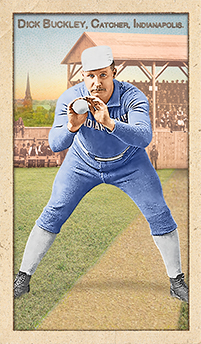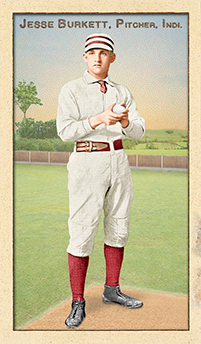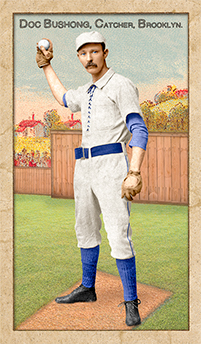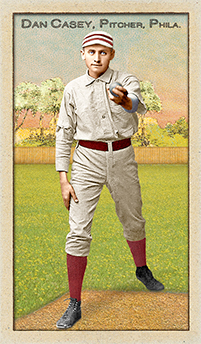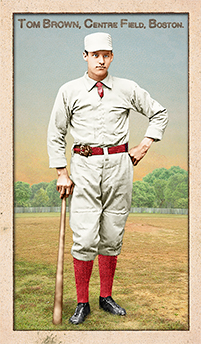
- Series: Beginnings: 1880's
- City: Boston
- Team: Beaneaters
- League: National League
Thomas Tarlton Brown (1860-1927) began a long career in MLB with the Baltimore Orioles in 1882. The young Englishman would go on to roam the outfields of ten franchises, ending with the NL’s Senators in 1898. Tom hit his stride with Boston’s Beaneaters and Reds. With the latter, he starred for a rare team to win pennants back-to-back in two leagues, as the Reds captured the Players’ League title in 1890 and the American Association flag in ’91. The fleet-footed Brown covered a lot of ground in the outfield, perhaps too much. He holds the MLB record for 490 OF errors, far more than the records in the AL and NL. His speed paid dividends on the bases as Tom led the league twice in steals, compiling a career total of 657.
- Selected for A.G. Spalding’s “World Tour” taking baseball global on an 1888 trip to Europe/Africa
- Enjoyed a career season in ’91, leading the AA in triples (21), SBs (106), hits (189) & runs (177)
- Is considered to have been part of the innovation of the platoon system with the ‘87 Indianapolis Hoosiers, paired with Gid Gardner
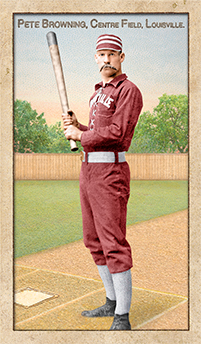
- Series: Beginnings: 1880's
- City: Louisville
- Team: Colonels
- League: American Association
Louis Rogers Browning (1861-1905) starred in the outfield for six teams over twelve seasons and was the best hitter in the ten-year history of the American Association. Pete’s nickname with the Eclipse was The Gladiator, but Browning is known to history as the Louisville Slugger: the first player to order bats from Hillerich & Bradsby after the owner’s son, Bud, invited the slumping slugger to the woodworking shop for a custom-made model that produced three hits the next day. Bud defied his dad’s unwillingness to bother with baseball equipment and sealed the company’s reputation when Honus Wagner became the first star to officially endorse a bat. Browning always ranked among the batting leaders and won the crown three times. Fighting the excruciating pain of mastoiditis with alcohol, Browning dominated at the plate even as his drinking increased. The chronic childhood affliction caused deafness and contributed to Pete’s erratic performance afield.
- Only four right-handed batters have eclipsed Browning’s .341 lifetime average
- A lifelong eccentric, driven by his demonic ailments, Pete lovingly named his bats and retired them when he deemed them to have used up their quota of hits
- Selected as SABR’s 2009 Overlooked 19th Century Legend still awaiting the Hall
- Pete's nephew, Tod Browning, was a film director best known for his films Dracula (1931) & the classic cult film Freaks (1932)
- Browning's uniform color in this card was changed from black to maroon in January, 2017 to reflect recent reliable research conducted by Craig Brown and friends at Threads of Our Game. Nine cards had been previously released featuring a black uniform.
- Series: Beginnings: 1880's
- City: Chicago
- Team: White Stockings
- League: National League
Charles Ruley Brynan (1863-1925) had two cups of coffee with major league clubs separated by three years. He was primarily a minor-league, right-handed pitcher with quick looks by two National League teams: the Chicago White Stockings in 1888 and the Boston Beaneaters in 1891. Along the way “Tod” played with two Southern Association teams in ‘86, the Nashville Americans and Memphis Grays followed the next year with the Duluth Freezers. In ‘88 Brynan played for the Minneapolis Millers and St Paul Apostles before getting a late-season chance with Chicago where he was 2-1 with a high 6.48 ERA. He fared worse with Boston, failing to get out of the first inning after giving up six.
- The remainder of his service had been with the Milwaukee Brewers, Des Moines Prohibitionists and Grand Rapids of the Michigan State League in 1889
- Brynan’s career mark in the minors was 31-39 with a 3.00 ERA

- Series: Beginnings: 1880's
- City: Columbus
- Team: Solons
- League: American Association
Albert C. Buckenberger (1861-1917) never made the big leagues as a player, but managed 4 franchises over 9 seasons from 1889-1904. He was the field general for the Columbus Solons of the AA for 2 years before moving to the NL, first with the Pirates for 3 seasons, the Browns for one and then with the Beaneaters for his final 3 campaigns. While with Pittsburgh, Al served a stint as club president as well. His career record on the bench was 488-539. By the time owner Chris von der Ahe brought him to St. Louis for the 1895 season, Buckenberger’s predilection for coaches’ hand signs was well known. He was the brunt of a mocking anecdote following the Browns’ 11th place finish. The Washington Post reported von der Ahe’s caustic assessment of the manager’s emphasis on teaching signals at the expense of physical conditioning: “I guess they have learned to make signs to the waiter in order to get more than their share to eat.” During the ’94 season, Buckenberger and others were expelled from the NL for “plotting” the resurrection of the American Association but was reinstated the next year.
- Buckenberger enjoyed 2d-place finishes in 2 leagues: with the Solons (AA) in 1890 and the Pirates (NL) in ’93
- Led the Beaneaters to a 3rd place finish in 1902
- Series: Beginnings: 1880's
- City: Indianapolis
- Team: Hoosiers (NL)
- League: National League
Richard D. Buckley (1858-1929) was a catcher with four teams over an eight-year career in the majors. He started with the Indianapolis Hoosiers in 1888 where he was behind the plate in 51 of his 71 games. Dick hit a robust .273 his rookie season. He played two full campaigns in Indiana, two with the Giants, two with St Louis and finished with two more with the Phillies, closing his MLB tenure in 1895 with a fine overall batting average of .245. Buckley wasn’t through with pro ball however, continuing in the minors with Midwest clubs until retiring at age 42 with the Omaha Omahogs of the Western League.
- Buckley was born to the game: in Troy NY just at the beginnings of organized ball. In 1860 the Victories of Troy were one of 62 teams in the new NABBP, reconstituted in ‘66 as the Unions of Lansingburgh (a neighborhood in north Troy) where young Dick would have seen baseball’s finest come through town
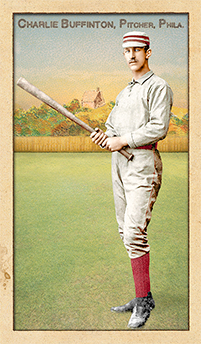
- Series: Beginnings: 1880's
- City: Philadelphia
- Team: Quakers
- League: National League
Charles G. Buffinton (1861-1907) was one of the most accomplished hurlers of his era; his sinker befuddling batters as it dove into the dirt. The Fall River native helped lead his Beaneaters to the title in 1883, ably supporting Grasshopper Whitney. The two combined for 62 of the team’s 63 victories. The following year was one of the most remarkable in baseball history and Charlie was one of its heroes, joining six others in shattering the previous strikeout record. Buffinton’s 17 Ks in a game remains the Braves franchise record. Boston’s try for a repeat championship died at the strong right hand of Old Hoss Radbourn who carried the Providence Grays with his mind-boggling 59 wins to Charlie’s 48. He went on to win 20+ seven times. His 233-152 lifetime record still ranks him 63rd in wins all-time. Typical of the era, Buffinton finished his own starts, an eye-popping 351 times out of 396. Only eight other pitchers of the 19th century exceeded his strikeout total.
- The New York World published a feature in 1886 “How Men Pitch a Base-Ball” and Buffinton was a prominent subject for the speed he attained from “but little effort”
- Series: Beginnings: 1880's
- City: Boston
- Team: Beaneaters
- League: National League
John J. “Black Jack” Burdock (1852-1931) began and ended his 18 year career in Brooklyn, first for the Atlantics and retiring from the Bridegrooms (Grooms). Played for the Hartford Dark Blues during their 1st year in the new National League, ‘76, and the next when Hartford became the Brooklyn Hartfords for a year.
- Sandwiched in between his stints in Brooklyn were 10 years with the Boston Beaneaters
- Was player/mgr for the Boston Beaneaters’ 1883 pennant winner, leading the club in average at .330
- One of the best infield defenders of his era, Burdock led the NL in putouts by a 2nd baseman five straight years, 1876-1880
- Led his league in fielding percentage by a 2nd baseman 6 times
- Achieved a career .250 batting average with 1,231 hits, 778 runs and 501 RBI
- Series: Beginnings: 1880's
- City: Indianapolis
- Team: Hoosiers (NL)
- League: National League
- Hall: National Baseball Hall of Fame
Jesse “the Crab” Burkett (1868-1953) was a Hall of Fame outfielder from 1890 to 1905. Following Ed Delahanty, Burkett became the second major leaguer to hit .400 twice (‘95 &’96 for the Cleveland Spiders.) Led the NL with .376 in 1901 while with the St Louis Cardinals.
- Still holds MLB record for inside-the-park HRs with 55
- First West Virginian elected to Hall of Fame
- Elected to Hall of Fame: 1946
- Jesse Burkett did not appear in the Old Judge series. This image is taken from a photo that appeared in The Sporting Times in February, 1890. Signed by Indianapolis as a young pitching phenom after the close of the 1889 season, Burkett would never pitch for the Hoosiers as the franchise folded before the 1890 season. Burkett then made his major league debut with the New York Giants in 1890 on a pitching staff that included Amos Rusie and Mickey Welch.
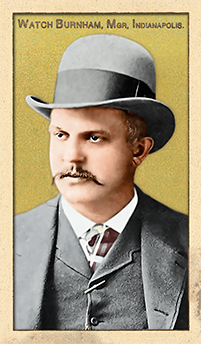
- Series: Beginnings: 1880's
- City: Indianapolis
- Team: Hoosiers (NL)
- League: National League
George Walter Burnham (1860-1902) was lured from the ranks of National League umpires to become the first manager of the new Indianapolis Hoosiers franchise when John Brush brought the beleaguered St Louis Maroons to a joyous community. “Watch” thus became a key figure in the sad saga of major league baseball in Indiana. The club lost every one of its arduous 22-game road trip and floundered all of the 1887 inaugural year. Burnham thought fining all the players might improve morale but captain Jack Glasscock mutinied. The Chicago Tribune reported the fear that “someday the men will decline to go on the field.” Days later Brush replaced Watch with another manager with no playing or managing experience and would try yet another neophyte, a sportswriter, before that dismal season mercifully ended with a 37-89 record. Burnham’s reputation preceded him to the Hoosiers and gave pause. The nickname was said to have derived from George’s failed attempt at self-promotion by presenting himself with an engraved watch during a Cleveland game in ‘83 that he was umpiring.
- Watch’s total experience officiating was 107 games scattered over five seasons between ‘83 and ‘95. He called Old Hoss Radbourn’s no-hitter on July 25, 1883
- The Hoosiers’ prospect finally seemed ready to improve in 1889 with the arrival of Amos Rusie. Sadly for the city, Brush parlayed his investment into a lucrative career with the Reds and Giants by dumping the woebegone Hoosiers after their third losing season
- Series: Beginnings: 1880's
- City: Baltimore
- Team: Orioles
- League: American Association
Thomas P. Burns (1864-1928) was an excellent player with four ML teams over 15 seasons. He starred for the Brooklyn Bridegrooms, leading them to two pennants in two leagues (1889 in the AA & 1890 in the NL.) His nickname derived from his offseason job hawking shellfish. He brought his huckstering skills to the park, annoying fellow players as “the noisiest man that ever played on the Brooklyn team.” He had a temper to match his mouth, once stabbing & severing a tendon of sleeping teammate Tom Daly, who was dozing on field between games of a double-header.
- NL home-run and RBI champion in 1890
- Compiled a .300 lifetime batting average
- Burns' uniform color on this card was changed in January, 2017 from black to blue & red to reflect recent reliable research by Craig Brown & friends at Threads of Our Game. Nine cards had been previously released featuring a black uniform.
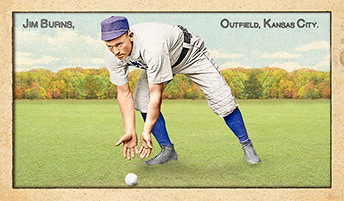
- Series: Beginnings: 1880's
- City: Kansas City
- Team: Cowboys
- League: American Association
James Milton Burns (1861-1909) was an outfielder for the Kansas City Cowboys and Washington Statesmen in three seasons. He played for the Kansas City Cowboys in 1888-89 and for Washington’s first season in the American Association, 1891. That was also the American Association’s final year and the team moved to the National League as the Senators. 1888 was KC’s first year in the AA and ’89 was their last, so Burns was with teams in flux. A productive hitter, his batting average over the three years was .305 with 111 RBI. Jim had begun with Oshkosh and Omaha in ‘86-88 before getting a trial with the Cowboys and he stayed with the team when it became the KC Blues of the Western Association in 1890. He had a brief stint with the Denver Mountaineers before joining the D.C. squad in ‘91. Burns stayed in the minors after his season with the Statesmen, playing exclusively in the Western Association for the Minneapolis Minnies/Millers, the Detroit Creams, Grand Rapids Gold Bugs and St. Paul Apostles
- Jim had a fine .332 average in his ten minor league seasons showing that his MLB stats were typical of a good hitter
- Series: Beginnings: 1880's
- City: Brooklyn
- Team: Bridegrooms
- League: American Association
Albert John Bushong (1856-1908). A poor hitter, Doc’s 16 year career and presence on 5 pennant winning teams are evidence of his defensive prowess. Bushong was so highly regarded that he was one of the first baseball players to endorse a product and even had a town in Kansas named for him: Bushong, Kansas: pop. 34.
- 5x pennant winner
- Some sources credit him with the invention of the catcher’s mitt
- Earned the nickname Doc because he was a dentist
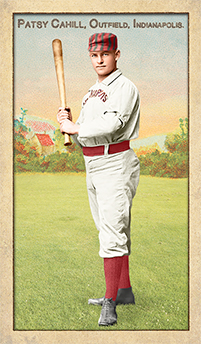
- Series: Beginnings: 1880's
- City: Indianapolis
- Team: Hoosiers (NL)
- League: National League
John Patrick Parnell Cahill (1865-1901) never did much damage to major league pitching but he hit well in the minors. Patsy’s brief stint in the big leagues included stops in Columbus, St. Louis and Indianapolis where the outfielder’s average was an anemic .205. A broken ankle with the Buckeyes ended his rookie season and may have been an omen that this gutty player belonged home in California. He had some great seasons out West, and the story gets retold that Ernest Thayer was so impressed by Patsy’s presence at the plate in a Stockton contest that he penned “Casey at the Bat” with him in mind. (The classic poem was published in 1888, the year before Cahill made it back to his home state). Patsy concluded his pro-ball in Texas with the Fort Worth Panthers in 1896.
- Cahill was versatile, even pitching several games and has been noted to have been part of the game’s first four-man rotation (for Columbus in ‘84 alongside the original “southpaw” Ed Morris)
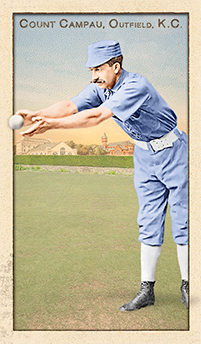
- Series: Beginnings: 1880's
- City: Kansas City
- Team: Blues (WA)
- League: Western Association
Charles Columbus Campau (1863-1938) may have been dubbed “The Count,” but he was the King of the Minors in the 19th century. No one matched his offensive output and he was prized especially for his defense. The scion of the French-Canadian founders of his native Detroit, Campau reigned in the society of the city and its ball fields. Educated at Notre Dame, he began playing there at an early age and soon came to dominate with his power and speed. He left Detroit with mentor Al Buckenberger to begin his pro career with Erie of the Interstate League in 1884. Thus began a two-decade tenure, mostly in the minors, that would take the Count to twenty different clubs including brief stints in the majors. His debut was back home with the Wolverines filling in for an injured Sam Thompson in ‘88. He stayed on with the newly constituted International League version of the Wolverines the following season and would have but one more turn in the big leagues, with the Browns in 1890 (save for two games with the Senators in ‘94). This would allow the hard-hitting Campau to claim a rare (unique?) distinction of leading the (minor league) International League and (major league) American Association in home runs in the same season. Charlie was known for his leadership skills and often served as on-field manager. Browns' owner Chris von der Ahe used him so in St. Louis that year and would call him “the best captain I have ever had.” Campau’s batting average could fluctuate, but his speed steadily improved to the point he was running foot races for prizes and was reputed to have never lost a match. The sketchy data of minor league stolen bases leaves a lot unknown but his feats were legendary. He swiped 100 bases in ‘87 and was renowned for a “home run” he hit by rounding the bases on a muffed pop-up in front of the plate.
- Campau continued in the minors through the 1905 season and umpired the following year. Never losing his love for speed, Charlie retired and went into the horse racing business and worked around the nation’s tracks in various capacities the rest of his life
- von der Ahe had sacked his prized manager for faithfully enforcing the owner’s own rules. The Count got a bit of revenge the next day, hitting an inside-the-park grand slam to the delight of St. Louis fans who rained down a deluge of cigars. Enough, Campau said, to open his own store
- Campau enjoys five known poses in the Old Judge canon
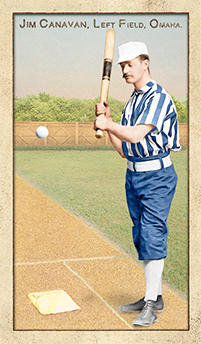
- Series: Beginnings: 1880's
- City: Omaha
- Team: Omahogs
- League: Western Association
James Edward Canavan (1866-1949) began in the major leagues during the 1891 season, playing more games for “King” Kelly’s Cincinnati “Killers” (aka “Porkers”) than any other team member. As the shortstop, Jim didn’t have a great average (.228) but he drove in the most runs, proving his clutch nature. Later that year, after the Killers were dissolved, Canavan and four others moved to Milwaukee. Canavan began and ended his pro-ball career in his native New England, beginning in New Hampshire and closing out his time in hometown New Bedford, playing and managing for the Whalers. After his rookie year, Jim played for Cap Anson’s Chicago Colts, then returned to the Queen City with the Reds before ending his big league tenure as a Brooklyn Bridegroom in 1897.
- Canavan piloted his New Haven Blues to the Connecticut State League pennant in 1902
- Captured here by the Old Judge photographers while with Omaha in 1889, Jim had a good year: 10 HRs, 93 Runs & 75 SBs in just 116 games
- Jim's uniform color on this card was changed in February, 2017 from red/white/black to blue/white/blue to reflect recent reliable research by Craig Brown & friends at Threads of Our Game. Five cards had been previously released featuring a red/white/black uniform.
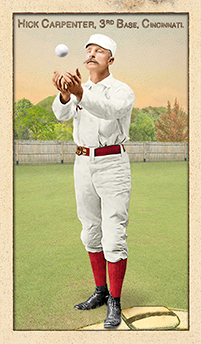
- Series: Beginnings: 1880's
- City: Cincinnati
- Team: Red Stockings (AA)
- League: American Association
Warren William Carpenter (1855-1937) was a solid-hitting, left-handed third baseman in the days when teams and leagues were figuring out modern baseball. “Old Hickory” began with the Syracuse Stars of Al Spalding’s League Alliance, a 28-team consortium that pioneered minor-league affiliation in 1877. He stayed the next year as the club joined the International League and made his MLB debut in ‘79 when the franchise became part of the National League. Two more NL clubs followed before Hick came into his own with the American Association’s Cincinnati Red Stockings from ‘82-89. His first season at Cincy was a great one as Carpenter led the league in hits & RBI with a .342 AVG. Over a twelve-year career Hick batted .259, collecting 1,200+ hits.
- Carpenter & Jimmy Macullar traveled to Cuba after the 1879 season, becoming the first North Americans to play in the Cuban League
- The lads’ Cuban League Colón club was so dominant that other teams refused to keep playing them
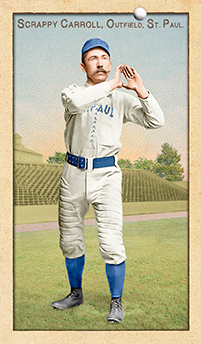
- Series: Beginnings: 1880's
- City: St. Paul
- Team: Apostles
- League: Western Association
John E. Carroll (1860-1942) began in MLB with the Union Association’s St. Paul White Caps in September 1884. The outfielder played in all nine games of the franchise’s only “season” going 3 for 31 with five errors. In ‘85, after stints with two minor-league clubs, Scrappy got a chance with the Buffalo Bisons of the NL. His .097 average fell when he went 3 for 41 in 13 games. Following time with the Utica Pent Ups, Carroll got his last chance in the majors with Cleveland’s Blues of the AA where he hit .199 in 57 games. His career average of .171 sent Scrappy permanently back to the minors. Old Judge misidentified one of his poses as being a Chicago Colts’ player, confusing him with Cliff Carroll.
- Carroll debuted in Cleveland on the city’s first Sunday game, August 3, 1887. He may or may not have innovated sunglasses, but he was noted for catching the attention of “the kranks” for donning “colored spectacles” one sunny day
- As so many before and since, Carroll had much more success in the minors, once even leading the Western League in home runs
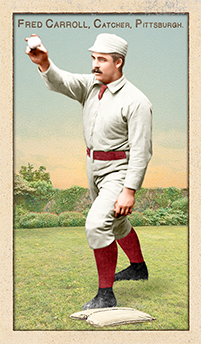
- Series: Beginnings: 1880's
- City: Pittsburgh
- Team: Alleghenys
- League: National League
Frederick Herbert Carroll (1864-1904) was born in Sacramento and, per Bill James, never really adjusted to life in the East. James touts Carroll as perhaps the finest “young” catcher, not only of his era, but until the arrival of Johnny Bench. Fred was nineteen when he started for the Columbus Buckeyes of the American Association. He moved on to spend seven more years in MLB for three Pittsburgh franchises in the AA, NL and Players' League. During this fairly brief tenure, Carroll twice hit over .300 and twice was among the league leaders in home runs. His career average of .284 justifies James' assessment of the rare hitter with power at catcher. Hall of Famer Buck Ewing set the standard for 19th century catchers, but Carroll was as solid as they come. Carroll had quite a year in 1886 with the Alleghenys. He set career marks in hits, doubles, triples and runs. And he also faced a club suspension for fighting teammate Otto Schomberg. Team owners, perhaps realizing how disliked Schomberg was, quickly ended Carroll's exile and lowered his fine to $50. The following season Fred became the first Pittsburgh player to hit for the cycle.
- In 1889 Carroll led the league in on-base percentage and slugging, said by the Encyclopedia of Baseball Catchers to be a record production for a catcher of that age (24)
- Carroll left the Steel City for his home state, playing for Oakland and SF in the minors
- Carroll's uniform color on this card was changed in February, 2017 from blue to red to reflect recent reliable research by Craig Brown & friends at Threads of Our Game. One card had been previously released featuring a blue uniform.
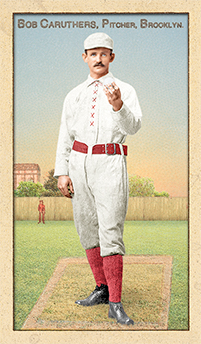
- Series: Beginnings: 1880's
- City: Brooklyn
- Team: Bridegrooms
- League: American Association
Robert Lee Caruthers (1864-1911) was a star pitcher, primarily for the Browns and Bridegrooms, leading his teams to five pennants in his 10-year career. Caruthers had the distinction of helping Brooklyn capture titles in consecutive seasons in two leagues: the AA in ’89 and the NL in ’90. One of the hardest working players of his day, Caruthers pitched in 340 games and played outfield in 366 as well as filling in occasionally at first and second. In 1886 while winning 30 games for St Louis, Caruthers had a league high .448 on base percentage, a pattern of plate and mound prowess that characterized this versatile dynamo.
- Caruthers won 40 for the Bridegrooms in ’89 and 23 the next year in the Senior Circuit
- Only Whitey Ford (barely) edged Caruthers in winning percentage for those with 200+ games
- No player who spent most of his career in the AA has made the Hall of Fame
- Caruthers' uniform color on this card was changed in January, 2017 from blue to red to reflect recent reliable research by Craig Brown & friends at Threads of Our Game. Nine cards had been previously released featuring a blue uniform.
- Series: Beginnings: 1880's
- City: Philadelphia
- Team: Quakers
- League: National League
Daniel Maurice Casey (1862-1943) was dubbed by Time “the Mudville Man” and helped inaugurate the Hall of Fame in 1939 with a stirring re-enactment of Casey at the Bat. Whether he was Ernest Thayer’s model or not, Casey was a fine pitcher for the Philadelphia Quakers, leading the NL in ERA in 1887. He pitched 7 years for 4 teams, won 96 games with two 20+ seasons.
- Became a candidate for THAT Casey by striking out, breaking Quakers fans’ hearts 8/21/87
- The week prior, Casey had won the game with his only career HR, inspiring the fans’ hopes
- In ’87 he won 28 of the 45 games he started, with a 2.86 ERA in 390 innings
- Series: Beginnings: 1880's
- City: St. Louis
- Team: Browns (AA)
- League: American Association
Elton P. Chamberlain (1867-1929) was a right-hander for 6 teams over 10 ML seasons, including at least one game he finished as a southpaw. A study in perseverance, the icy-calm Chamberlain doggedly refused to give in to Boston’s Bobby Lowe on May 30, 1894, eventually surrendering 4 HRs to a batter for the first time in history. Lowe added a single to keep Ice Box in the record books for most total bases to a batter in one game. In 1888-89 he went 25-11 and 32-15 for the Browns.
- Led the American Association with six shut-outs in 1890 for the Columbus Solons
- Completed 264 of his 301 career starts and ranks 64th all time in that statistic
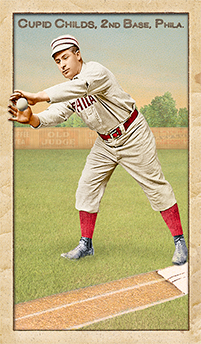
- Series: Beginnings: 1880's
- City: Philadelphia
- Team: Quakers
- League: National League
Clarence Algernon Childs (1867-1912) was not only a fine second-baseman, he was an excellent batsman with a knack for getting on base. He played 13 seasons in the majors for five clubs. His best years were the eight he spent with the Cleveland Spiders where he played alongside Cy Young, Jesse Burkett, Bobby Wallace, Buck Ewing, George Davis and John Clarkson. Never elected to the Hall of Fame, Cupid’s on-base percentage exceeds that of every second-baseman in Cooperstown but Rogers Hornsby and Eddie Collins and his lifetime .306 average is better than a dozen who made it in. The stocky Childs was dubbed “the dumpling” by a Grand Rapids reporter describing his tryout with Kalamazoo in 1888. Yet, the article said Cupid could cover more ground than most. His arrival in Cleveland resulted from a favorable ruling in a nationally publicized case when the Orioles tried to hold him to a contract ruled null. Childs fit in well with Patsy Tebeau’s “hooligans” through the 1890s.
- Ranks 24th all-time in OBP (.416), just behind Stan Musial
- Had a great eye at the plate, striking out only once every 26 at bats
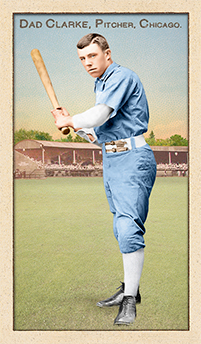
- Series: Beginnings: 1880's
- City: Chicago
- Team: White Stockings
- League: National League
William H. Clarke (1865-1911) learned early why the major leaguers get the big bucks: he had uniformly outstanding success on the mound in the minors with an overall 1.81 ERA. Things were always tougher with the big clubs: an ERA of 4.16 and a journeyman record of 44-51 during seven seasons. Dad’s best year came with the Giants in 1895 where he won 18 with a 3.39 ERA. Things must have looked different when he came out of Lorain, OH to the Sandusky Suds in 1887 winning 21 with a rookie ERA of 1.13. Similar results followed in Des Moines and Omaha. Clarke even got to do a turn out west with the San Francisco Haverlys and a short stay with the Jacksonville (IL) Lunatics where it must have maddened him to go 3-3 despite a 0.87 ERA. Always a strong-willed character (the nickname reflected a grizzled visage), Dad sparred and stormed through a long up-and-down career.
- Per SABR, Dad’s innovative “system” of pitching “slants” influenced Big Train Johnson to perfect his own motion

- Series: Beginnings: 1880's
- City: Boston
- Team: Beaneaters
- League: National League
- Hall: National Baseball Hall of Fame
John Gibson Clarkson (1861-1909) won 328 games, won the triple crown in 1889 and twice pitched more than 600 innings in a season. In 1885, John appeared in 70 games, threw 68 complete games, 623 innings, won 53, had an ERA of 1.85, a no-hitter, and won the pennant. Apparently having to hurl the sphere a mere fifty feet was a tonic to the arm. But unlike so many pitchers of his era, Clarkson didn’t flame out from such prodigious labor on the mound. From 1885-92 he AVERAGED 36 wins per season and would win 30+ an extraordinary six times. This great career began with the Worcester Ruby Legs in 1882, flowered with Cap Anson’s Sox in ‘84 and fully bloomed in Boston when John followed his ace catcher King Kelly to the Beaneaters in ‘88. League politics that culminated in the Players’ League revolt took a toll on Clarkson’s reputation and sundered his friendship with Kelly as the hurler remained loyal to the Nationals.
- Cleveland acquired John in 1892 allowing him to team with Cy Young. Chief Zimmer, who caught Young for a decade, proclaimed Clarkson the best he ever saw
- Elected to Hall of Fame: 1963
- Although the Old Judge series features seven known poses of John Clarkson (all in a Chicago White Stockings uniform), this image is taken from a cabinet photo produced by the Conly Studio in Boston.

- Series: Beginnings: 1880's
- City: Philadelphia
- Team: Quakers
- League: National League
John Clements (1864-1941) was known best for being a left-handed catcher and, by far, the most durable and enduring southpaw ever to play the position in the majors. Jack caught four times as many games (1,073) as any other port-sider in history and was the last to catch regularly in the major leagues. Jack played 17 seasons and is credited as the first receiver to wear a chest protector. His .394 BA in 1895 is highest ever at his position and he was among the top four in batting average three times. He was also the first big leaguer to catch 1,000 games. Clements’ power was such that, upon retirement, he was the all-time leader for catchers in single-season and career home runs. Jack came up with the Union Association’s Philadelphia Keystones in that league’s sole season, 1884. When the team folded in August, Jack became the backstop for the National League’s Quakers (Phillies) franchise for 14 seasons before playing out his MLB career with three other teams.
- Jack had trouble laying down the tools. In 1900, following his final year in the NL, he played for the only minor league squad of his long career, a dozen games with the Providence Clamdiggers. He hit .295




